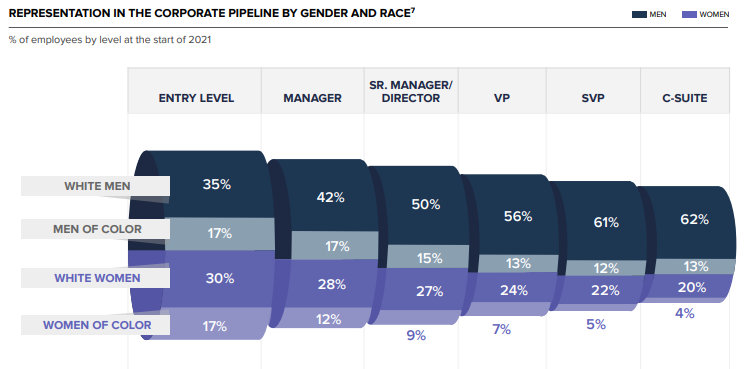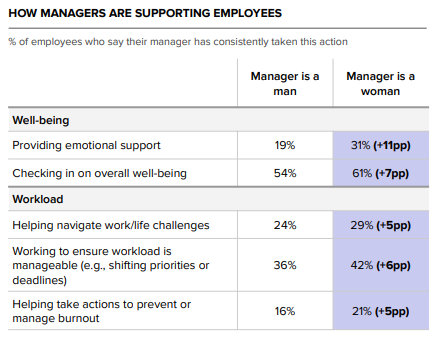Results from the sixth annual Women in the Workplace report are in, and the 2021 results may provide insight into the roles and work of women, both within your own teams as well as during your work with your clients.
The study was launched in 2015 by Lean In and McKinsey. The 2021 Women in the Workplace report (full report here) was based on talent pipeline and/or policies and programs data from 423 private, public, and social sector companies and an employee experience survey completed by over 65,000 employees from 88 companies.
Women Remain Under-Represented in Leadership
Although the report shows that representation of women over the pipeline from entry-level to C-suite positions has improved in the past year, there is still a great disparity between leadership roles for men and women, which is even more significant for women of color. As seen in this chart from the report, men occupy 75% of C-suite positions while women of color only occupy 4% of those seats.

In fact, promotions to the first step to management are not equitable for women, with women of color losing ground at every step up the ladder. For every 100 men promoted to manager, only 86 women are promoted. This discrepancy at the initial step has led to a slower improvement over the past year at the higher ends of the pipeline than the improvement from entry-level to manager.
Women Face Higher Burn Out Levels
As women are facing under-representation in leadership roles, they are also facing more burnout than their male counterparts. The report specifically found, "Women are even more burned out than they were a year ago, and the gap in burnout between women and men has almost doubled. In the past year, 1 in 3 women has considered leaving the workforce or downshifting their careers—a significant increase from 1 in 4 in the first few months of the pandemic." (p. 13)
It may not be highly significant that women are more burned out during this past year of the pandemic; however, it is critical to emphasize this line - the gap in burnout between women and men has almost doubled.
Women Managers Do More to Support Their Teams
Obviously, the pandemic has created incredible amounts of upheavals in lives across the world. Employees as a whole are facing high levels of stress, including the burnout already discussed. However, burnout for women managers is a vicious cycle. Managers who are women are more likely than men to support the well-being of their team members, as shown in the chart below. And women who manage teams are even more likely to experience burnout than women who do not manage teams, even to the extent that 40% of women managers have considered leaving the workforce entirely or moving to a less demanding role.

Diversity, Equity and Inclusion
The report continues to discuss critical topics such as leadership in diversity, equity and inclusion (DEI) and the fact that despite increased DEI initiatives over the past year, women of color continue to face inequity in their day-to-day experiences. These discussions and topics will be addressed in a second article in the next week.
.png?width=150&height=63&name=TWRlogo-regmark_blueblack%20(1).png)
.png)









Do you have questions about this article? Email us and let us know > info@woodard.com
Comments: